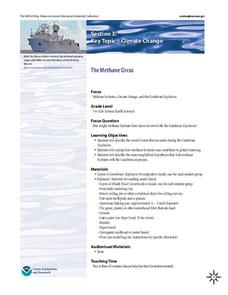NOAA
What's the Big Deal?
Who knew that a possible answer to Earth's energy resource problems was lurking deep beneath the ocean's surface? Part four of a six-part series introduces Earth Science pupils to methane hydrate, a waste product of methanogens. After...
NOAA
Chemosynthesis and Hydrothermal Vent Life
What's life like in a hydrothermal vent? Find out in part five of a 13-part series. Learners journey to one of the harshest environments on the planet, the hydrothermal vent, to learn about the creatures that survive the extreme...
NOAA
Animals of the Fire Ice
When the sun's rays can't reach the producers in a food web, where does all the energy come from? Extreme environments call for extreme food sources. Young scientists investigate creatures that appear to get their energy from methane...
NOAA
The Methane Circus
Step right up! An engaging research-centered lesson, the third in a series of six, has young archaeologists study the amazing animals of the Cambrian explosion. Working in groups, they profile a breathtaking and odd creature and learn...
Encyclopedia of Earth
Encyclopedia of Earth: Evolutionary Biology: Extremophile
Article describing some of the extreme environments where extremophile organisms can live, and giving examples from bacteria, archaea, flora, and fauna. (Published: November 26, 2010)
PBS
Pbs Nova: The Mysterious Life of Caves
Companion to a PBS program in the Nova series. There are wonderful photos of the Lechuguilla cave system in New Mexico, and some new information on how caves are formed.
Science Education Resource Center at Carleton College
Serc: Microbial Life: Microbial Life in Extreme Environments
Here is comprehensive information about microbes living in extreme conditions. Explore the definition of extremophile, what makes an extreme environment, and types of extreme environments. Site includes pictures, information and other...
CK-12 Foundation
Ck 12: Life Science: Types of Archaea
[Free Registration/Login may be required to access all resource tools.] The first archaea described could survive in extremely harsh environments in which no other organisms could survive. As a result, archaea are often distinguished by...
Science Education Resource Center at Carleton College
Serc: Microbial Life: Los Angeles and the Future of Mono Lake: Web Quest
Student WebQuest studying biodiversity, preservation, and natural history. Students act as political advisors exploring Mono Lake's life forms the impact humans have on the environment. After researching the issues, students create a...
Science Education Resource Center at Carleton College
Serc: Microbial Life: Protistan Tales of Atlantic White Cedar Swamps: Webquest
Tap into your students' imagination as they create a story to describe microbes. This WebQuest has students studying microbial diversity of Atlantic White Cedar Swamps. After their investigation, students will describe the physical...
PBS
Nova: The Lives of Extremophiles
An interview with a microbiologist who studies bacteria that decompose hydrogen sulfide gas and other noxious chemicals. The interview focuses on her research and her career.












